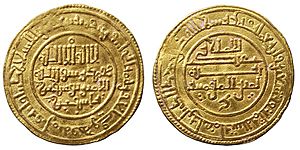Aghmat facts for kids
Quick facts for kids
Aghmat
Aɣmat
أغمات
|
|
|---|---|
|
Town
|
|
| Aghmat / Aɣmat | |
| Country | |
| Region | Marrakech-Asfi |
| Province | Al Haouz |
| Time zone | UTC+0 (WET) |
| • Summer (DST) | UTC+1 (WEST) |
Aghmat (pronounced Ughmat) was a very important trading town in Morocco during the Middle Ages. It was home to the Berber people, who are an ethnic group native to North Africa. Today, Aghmat is an archaeological site, meaning a place where old ruins are studied. It is known as "Joumâa Aghmat".
The town is about 30 kilometers (18 miles) southeast of Marrakech. It sits along the Ourika River road. Sometimes, you might see the name spelled as "Ghmat" or "Ghmate".
An old Berber story says that Aghmat was a Christian Berber town. It was supposedly taken over by Muslim forces in 683. These forces were led by Uqba ibn Nafi, a general from the Umayyad Caliphate in Syria. However, this story was first written down almost 700 years later. Many historians do not believe it. An earlier historian, al-Baladhuri, wrote that Musa bin Nusair conquered the Sous region and built a mosque in Aghmat.
Contents
Aghmat's Early History
After the death of Idris II in 828, Morocco was divided among his sons. Aghmat became the capital of the Souss region under Prince Abd Allah, who was part of the Idrisid family.
The Almoravid Takeover
Later, a group called the Almoravids came from the Sahara Desert. Their leader was Abd Allah ibn Yasin. Aghmat was defended by Laqūt, the leader of the Maghrawa tribe. But Laqūt was defeated. The Almoravid army entered Aghmat on June 27, 1058.
One of the richest people in Aghmat was Laqūt's widow, Zaynab an-Nafzawiyyat. She married the Almoravid leader, Abu-Bakr Ibn-Umar. Her great wealth helped him a lot. After Abu-Bakr went back to the Sahara Desert in 1071, Zaynab married his successor, Yusuf ibn Tashfin.
Aghmat and Marrakech
By 1068, Aghmat had grown very crowded. So, Abu-Bakr Ibn-Umar decided to build a new capital city. He founded Marrakech in 1070. After Marrakech was built, Aghmat became less important.
The Almoravids continued to use Aghmat as a quiet place to send people who were no longer in power. One famous person exiled there was Al Mutamid. He was a former king of Seville and Córdoba, and also a well-known poet. His tomb in Aghmat is still a place where people visit today. Another king, Abdallah ibn Buluggin from Granada, also wrote his life story while exiled in Aghmat.
Battles and Changes
Between 1126 and 1130, Aghmat saw several battles. These fights were between the Almoravid sultan Ali ibn Yusuf and the Almohad army. The Almohad army was led by Ibn Tumart and Abd al-Mu'min. Eventually, the Almoravid forces were defeated across Morocco and Algeria. Abd al-Mu'min then entered Aghmat without a fight on June 27, 1146.
In 1860, a writer named Beaumier said that Aghmat still had about 5,500 people living there. About 1,000 of them were Jewish.
Aghmat's Economy in the Past
In the 11th century, before the Almoravids became powerful, a writer named Al Bakri described Aghmat as a thriving city. He wrote that 100 cattle and 1,000 sheep were sold every Sunday at the local market, called a souk. The people of Aghmat even elected their own leader.
There were actually two parts to Aghmat. The main trading and political center was called "Aghmāt Wurīka". About 8 miles away was "Aghmāt Aylan," which was closed to outsiders. The town also had a seaport called Qūz on the Atlantic coast, about three days' journey to the west.
Aghmat in Modern Times
On November 18, 1950, when France ruled Morocco, a group of Moroccan nationalists held a protest. They were part of the Istiqlal Party. The protest took place at the tomb of Al-Mutamid. Police violently stopped the protest. This happened under orders from Boujane, who was a local leader. This event became a major problem between Boujane's boss, the powerful Pasha of Marrakech T'hami El Glaoui, and the King of Morocco Mohammed V. It eventually led to the king being briefly removed from power.
Today, you can see the archaeological ruins of Aghmat. These include parts of the old city walls, a hammam (public bath), pieces of houses, and qanats (underground irrigation canals). You can also see about a hundred meters of the city's old defensive walls.
The tomb of Al-Mutamid is marked by a modern mausoleum. It was built in 1970 and has a dome shaped like the Almoravid style.
See also
 In Spanish: Agmat para niños
In Spanish: Agmat para niños



